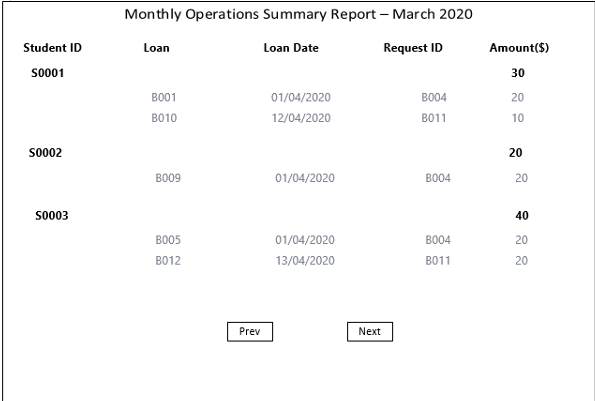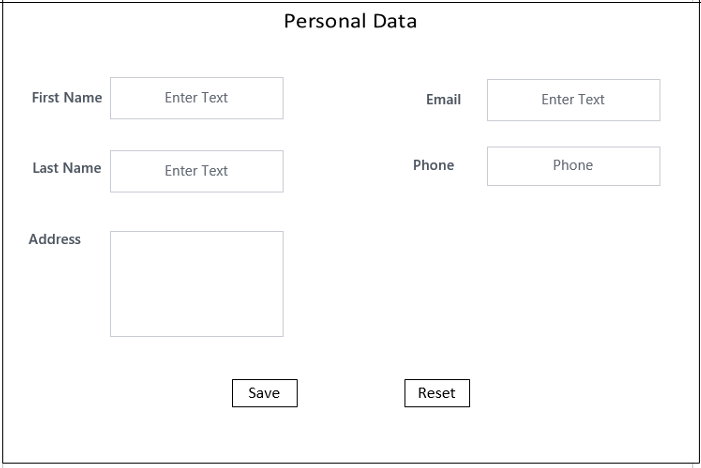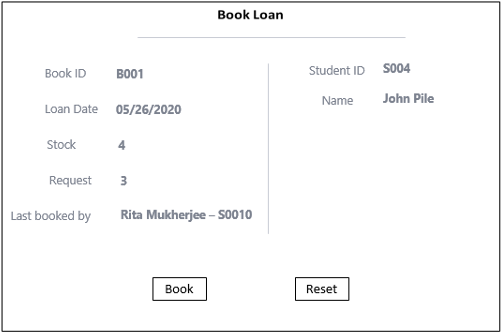Library Management System Assignment: Designing User Interface Screens
Question
Task:
The Proposal assessment covers the following topics: information system development, system
development approaches, user and system interfaces, and system testing, deployment and
maintenance.
Proposal: Design for Library website in your local area
Your local’s Library has hired you to design two online data entry screens. Visit various library
websites and based on what you know and gather about the operation of a library services, submit
your proposal while including the following questions:
• Design a monthly operations summary report that will comprise overall data on student ID,
loans, late charges, requests and anything else you think a library staff might want to review.
Be sure to include numeric activity and dollar totals.
• Design a data entry screen for entering Personal Details.
• Design a book loan input screen. In addition to the book data, the book loan form must
include the following fields: Student Number, Name, and Date.
• Plan the suitable testing and deployment activities.
Answer
Introduction
This report on library management system assignment aims at analysing the need for automating local library services. It includes the information system development of the proposed library management system along with designing the user interface screens. The library management system assignment states the case description i.e. present the key functionalities of the proposed system. Then, it discusses the design of three critical screens of the proposed system. Testing and deployment are two phases of development of any system. This library management system assignment discusses the testing and deployment activities which are to be carried out to come up with a fully functional library management system.
Case description
The proposed system is to develop an automated library management system which eliminates data inconsistencies in the current manual handling of book loan. Following are key requirements of the proposed system provided within this library management system assignment:
Functional requirements
Following are key functional requirements of the proposed library management system:
- User should be able to search a book using different criteria such as book name, ISBN number, author name, publication name, etc.
- User should be able to book a loan for a defined time period.
- User should be able to return the books and in case of late penalties, librarian or super admin should allow user to return book only after paying the accumulated fine.
- User should be able to register them in the proposed system.
- Users should be able to login in the system using valid login credentials.
- Administrator should be able to update and delete the users of the system (Valacich, George & Hoffer, 2017).
- Administrator should be able to add, delete and update books in the system.
- System should be able to update stock of the books based on the booking and returning of the books.
Non-functional requirements
Following are key non-functional requirements of the proposed library management system:
- The systems should be reliable i.e. it should be available 24 x 7.
- The system should be accessible from any location which has internet and it should be independent from the underlying devices. The system should be responsive enough for the mobile or tablet devices.
- The user interface of the proposed system should have least learning curve.
- The user interface should guide the user for next appropriate action during executing a operation.
- The system should be able to handle huge number of transactions at a time.
- The proposed system should have low throughput time to provide excellent performance (Koelsch, 2016).
- The system should secure privacy of the users along with the confidentiality, integrity and availability of the data.
User Interface
Monthly operation summary report

(Galitz, 2007)
This user interface presented in the library management system assignment shows the monthly summary report of book loan by student. For instance: in the given screen there are few attributes taken from STUDENT and LOAN entities. STUDENT attributes are as follws:
- Student_ID – Unique identifier of the student.
LOAN attributes provided in the library management system assignment are as follows;
- Loan – It is the unique identifier of BOOK.
- Loan_date – It tis the date on which book has been taken on loan.
- requestID – It is the unique identifier of the REQUEST entity which stores the data of all requests made by the students for borrowing the book
The amount represents the total fine on the book incurred by the respective student.
Data entry screen
The screen provided in following section of library management system assignment represents the registration / profile of new / old student. The screen asks users to enter data in following fields:
- First Name – It depicts the first name of the student.
- Last Name – It depicts the last name of the student.
- Address – It depicts the complete address of the student.
- Email – It depicts the contact email address of the student.
- Phone – It depicts the contact phone number of the student.
Along with these fields mentioned above within this library management system assignment, two buttons are present – “Save” and “Reset”. “Save” button shall submit the form and sends details to the business logic layer. “Reset” button shall erase all the entered data in the fields and do not any information to the database.

(Wilson, 2012)
Book loan input screen
The book loan screen attached in the next section of library management system assignment shows the details of the student and book to be loan. The screen has following fields:
- Book ID – Unique identifier of the book to be loaned.
- Loan date – It is the date on which book is sent for loan.
- Stock – It represents the total number of copies of book available for loan.
- Request – It represents the total number of requests received for the book to be loaned.
- Last booked by – It shows the details of student who last took the book on loan.
- Student ID – Unique identifier of the student who is about to loan the book.
- Name – Full name of the student who is about to loan the book.

(Hutt, 1993)
What are the testing activities used in the case scenario of library management system assignment?
Testing shall be conducted at various stages. First of all unit testing will be conducted after completion of each module or iteration of software development lifecycle. Thereafter, system testing shall be performed to test the application from different perspective. It checks whether the features are working without any break in the application flow. User acceptance testing shall be carried out to test whether the developed system fulfils the expectations of end users.
Bottom-up testing methodology shall be used to conduct the testing of the application. As per this methodology, first of all the lower level functionalities shall be tested which are followed by directly above them. This methodology provided in the library management system assignment has been selected so that units are tested before combining functionalities in order to validate and verify the performance.
Following are two test plans which will be conducted to test the proposed library management system:
White box test plan
Testing types – Following testing types will be conducted to carry out the activities of white box test plan:
- Code coverage – Source code of the developed library management system will be run and al the code lines are verified to ensure that there are not errors present in the developed code.
- Segment coverage – Segments of code are executed in this type of testing in order to ensure that code’s performance is adequate.
- Branch coverage – Every branch of code is executed in this type of testing.
- Compound condition coverage – Following coverage of conditions shall be done:
- Display home screen of the proposed LMS only to the authenticated users who enter valid login credentials or else display an appropriate error message.
- Provide loan data of the student on entering correct student ID or else display an appropriate error message.
- Allows users to register in the system if the entered details generate unique ID or else ask users to enter new details.
- Mark student as excellent if there has been on late fees on any of the book loan; good if there is only 5% late fee fine and poor if there are more than 10% of late fee fines.
- Data Flow Testing – In this testing, validation of all possible values in all the fields of the system need to be validated.
- Loop testing – All loops are tested i.e. single, concatenated and nested.
Defect Logging Process
Following steps illustrated in the library management system assignment will be carried out for defect loggings:
- Click on Bugzilla tool
- Enter following bug details:
- Summary of defect
- Choose category as white box defect
- Reproduction steps
- Responsible team resource
- Rate of responsibility
- Supporting references
- Submit bug
Roles & Responsibilities – Following are key resources of the testing plan:
- System tester – This resource is responsible for carrying out all testing activities and identifying all bugs. All bugs are required to be entered in the system.
- Test Manager - This resource is responsible for developing and determining the testing methodology to be used for performing test processes.
- Test Analyst – This resource is responsible for creating test cases and test reports.
Black Box Test Plan
Testing Types - Following testing types will be conducted to carry out the activities of black box test plan:
- Security testing – This type of testing ensures that system satisfies the integration of security tools and controls in the proposed system.
- Integration testing – This type of testing integrates modules and test the performance of these integrated modules as a whole.
- System testing – This type of testing includes testing of functional aspects of the proposed application. All the modules and requirements of the system are required to be tested.
- Regression testing – Testing team will log various types of bugs in the tool. The development team shall resolve those bugs. Then testing team again tests those resolved bugs to ensure that defects are correctly so that it does not beak code of any other part of the developed system. (Zobrist, Bagchi & Trivedi, 1998)
Test coverage matrix
|
ID |
Test Scenario & Cases |
Test Case Status |
Actual Outcome |
Defect ID |
Comments |
|
1 |
Login functionality - admin, student, librarian |
Fail / Pass |
Data to be entered |
Defect unique identifier |
NA |
|
2 |
Registration |
Fail / Pass |
Data to be entered |
Defect unique identifier |
NA |
|
3 |
To view the books |
Fail / Pass |
Data to be entered |
Defect unique identifier |
NA |
|
4 |
To calculate fine and cost of the book |
Fail / Pass |
Data to be entered |
Defect unique identifier |
NA |
|
5 |
Ability to reserve book |
Fail / Pass |
Data to be entered |
Defect unique identifier |
NA |
|
6 |
Ability to view and download monthly reports |
Fail / Pass |
Data to be entered |
Defect unique identifier |
NA |
|
7 |
Manage user accounts |
Fail / Pass |
Data to be entered |
Defect unique identifier |
NA |
|
8 |
Manage user account data |
Fail / Pass |
Data to be entered |
Defect unique identifier |
NA |
|
9 |
Logout feature |
Fail / Pass |
Data to be entered |
Defect unique identifier |
NA |
|
10 |
System availability |
Fail / Pass |
Data to be entered |
Defect unique identifier |
NA |
|
11 |
System reliability |
Fail / Pass |
Data to be entered |
Defect unique identifier |
NA |
|
12 |
System Performance |
Fail / Pass |
Data to be entered |
Defect unique identifier |
NA |
|
13 |
Security of the system with respect to encryption and access control |
Fail / Pass |
Data to be entered |
Defect unique identifier |
NA |
|
14 |
Maintenance of the system |
Fail / Pass |
Data to be entered |
Defect unique identifier |
NA |
|
16 |
System Usability |
Fail / Pass |
Data to be entered |
Defect unique identifier |
NA |
|
17 |
Visual appearance of the system |
Fail / Pass |
Data to be entered |
Defect unique identifier |
NA |
|
18 |
System consistency |
Fail / Pass |
Data to be entered |
Defect unique identifier |
NA |
Deployment activities
As per the investigation carried on this library management system assignment, deployment is an optional stage in software development lifecycle where in final software is installed on workstations as an application which is to be accessible to users in runtime state. However, software deployment is not required but it comes under the customer support activity and hence it has now become a part of software development. Software distribution in deployment is not synonymous to each other (Zobrist, Bagchi & Trivedi, 1998).
It is evident herein library management system assignment that software deployment includes both installation and up gradation. It starts with the new release order from the organization and includes all the steps to be taken until customer is satisfied with the deployed system:
|
Class |
Actions |
Who |
Install / Update |
|
Stakeholders |
· Inform stakeholders about the contents of deployment. · User training · User support |
Vendor Vendor Vendor |
Both Both Both |
|
Preparations of installations |
· Import initial data · Configure final product · Product integration · Deployment date scheduling · Deployment package creation |
Vendor Both Vendor Vendor Vendor |
Install Both Install Both Both |
|
Installation |
· Checking pre-installation · Rollback · Product installation · Transferring product from test to production · Maintain data regarding deployed systems |
Vendor Vendor Both Vendor Vendor |
Both Update Both Both Both |
|
Testing |
· Testing at site of vendor · Testing at site of customer |
Vendor Both |
Both Both |
Conclusion
Functional and non-functional requirements explored in the above sections of library management system assignment play an important role in depicting the key features of the proposed library management system as they decide the business logic and user screens of the system. User interface screens have been designed in a way that they possess a very low learning curve or the user to start working on it. Along with this, two strategies have been framed for testing i.e. white box and black box testing. The proposed systems shall follow the bottom up testing approach. Deployment activity shall include getting the key data first in the proposed system before moving the other non-essential data.
References
Galitz, W. (2007). The Essential Guide to User Interface Design (2nd ed., pp. 45-46). Hoboken: John Wiley & Sons.
Hutt, A. (1993). User interface (1st ed., pp. 34-36). New York: Prentice Hall.
Koelsch, G. (2016). Requirements Writing for System Engineering (2nd ed., pp. 11-13). Berkeley, CA: Apress.
Valacich, J., George, J., & Hoffer, J. (2017). Essentials of systems analysis and design library management system assignment (2nd ed., pp. 23-26).
Wilson, M. (2012). Search user interface design (1st ed., pp. 22-25). Morgan & Claypool Publishers.
Zobrist, G., Bagchi, K., & Trivedi, K. (1998). Advanced computer systems design (1st ed., pp. 23-26). Amsterdam: Gordon & Breach.












